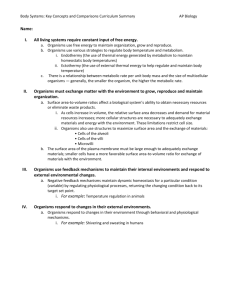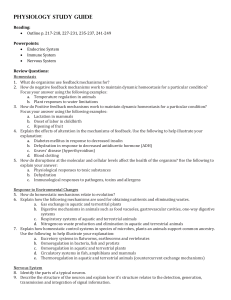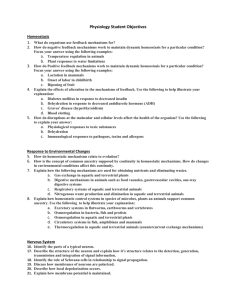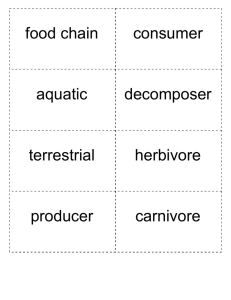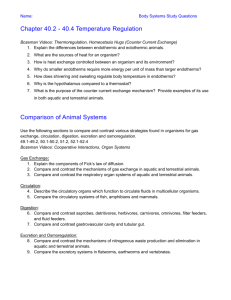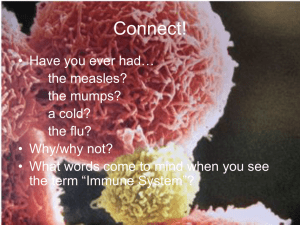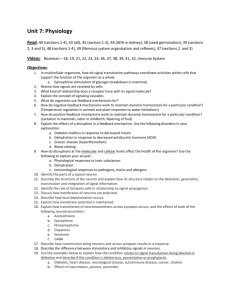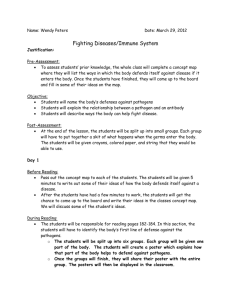The ESSENTIAL KNOWLEDGE for Organism Form
advertisement
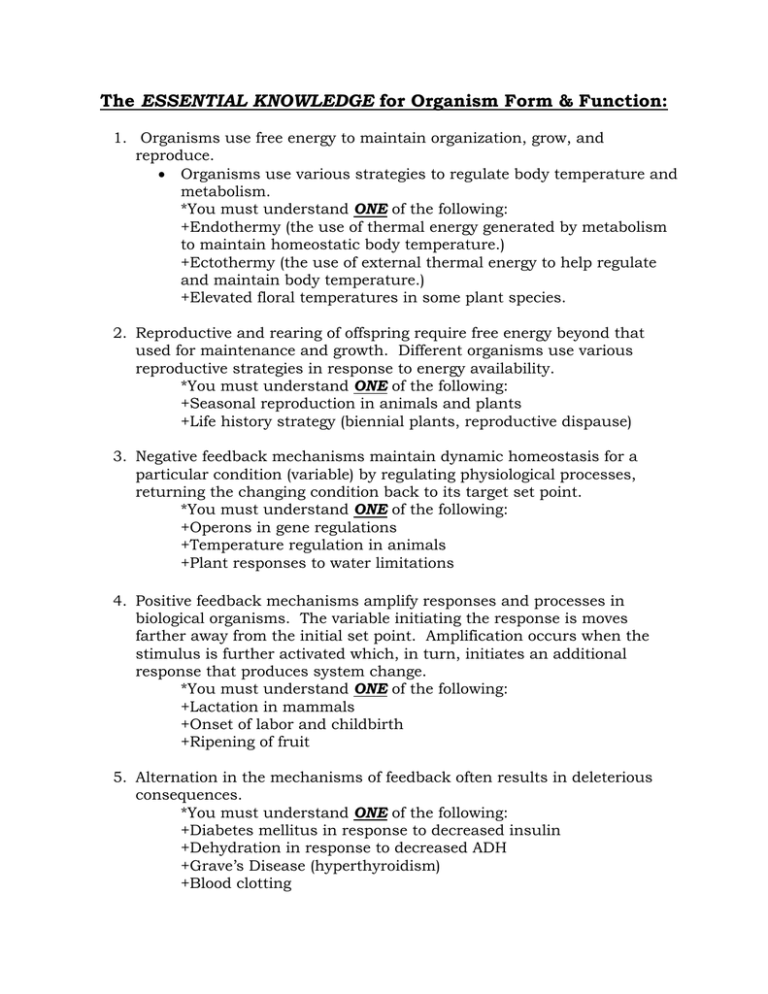
The ESSENTIAL KNOWLEDGE for Organism Form & Function: 1. Organisms use free energy to maintain organization, grow, and reproduce. Organisms use various strategies to regulate body temperature and metabolism. *You must understand ONE of the following: +Endothermy (the use of thermal energy generated by metabolism to maintain homeostatic body temperature.) +Ectothermy (the use of external thermal energy to help regulate and maintain body temperature.) +Elevated floral temperatures in some plant species. 2. Reproductive and rearing of offspring require free energy beyond that used for maintenance and growth. Different organisms use various reproductive strategies in response to energy availability. *You must understand ONE of the following: +Seasonal reproduction in animals and plants +Life history strategy (biennial plants, reproductive dispause) 3. Negative feedback mechanisms maintain dynamic homeostasis for a particular condition (variable) by regulating physiological processes, returning the changing condition back to its target set point. *You must understand ONE of the following: +Operons in gene regulations +Temperature regulation in animals +Plant responses to water limitations 4. Positive feedback mechanisms amplify responses and processes in biological organisms. The variable initiating the response is moves farther away from the initial set point. Amplification occurs when the stimulus is further activated which, in turn, initiates an additional response that produces system change. *You must understand ONE of the following: +Lactation in mammals +Onset of labor and childbirth +Ripening of fruit 5. Alternation in the mechanisms of feedback often results in deleterious consequences. *You must understand ONE of the following: +Diabetes mellitus in response to decreased insulin +Dehydration in response to decreased ADH +Grave’s Disease (hyperthyroidism) +Blood clotting 6. Organisms respond to changes in their environment through behavioral and physiological mechanisms. *You must understand ONE of the following: +Photoperiodism or phototropism in plants +Hibernation or migration in animals +Taxis and kinesis in animals +Chemotaxis in bacteria, sexual reproduction in fungi +Nocturnal and diurnal activity, circadian rhythms +Shivering and sweating in humans 7. Continuity of homeostatic mechanisms reflects common ancestry, while changes may occur in response to different environmental conditions. 8. Organisms have various mechanisms for obtaining nutrients and eliminating wastes. *You must understand ONE of the following: +Gas exchange in aquatic and terrestrial plants +Digestive mechanisms in animals such as food vacuoles, gastrovascular cavities, one way digestive systems +Respiratory systems of aquatic and terrestrial animals +Nitrogenous waste production and elimination in aquatic and terrestrial animals 9. Homeostatic control systems in species of microbes, plants and animals support common ancestry. *You must understand ONE of the following: +Excretory systems in flatworms, earthworms, and vertebrates +Osmoregulation in bacteria, fish, and protists +Osmoregulation in aquatic and terrestrial plants +Circulatory systems in fish, amphibians, and mammals +Thermoregulation in aquatic and terrestrial animals (countercurrent exchange mechanism) 10. Disruptions at the molecular and cellular levels affect the health of the organism. *You must understand ONE of the following: +Physiological responses to toxic substances +Dehydration +Immunological responses to pathogens, toxins, and allergens 11. Plants, invertebrates, and vertebrates have multiple, nonspecific immune responses. *You must understand ONE of the following: +Invertebrate immune systems have nonspecific response mechanisms, but they lack pathogens specific defense responses. +Plant defenses against pathogens include molecular recognition system with systemic responses; infection triggers chemical responses that destroy infected and adjacent cells, thus localizing effects +Vertebrate immune systems have nonspecific and nonheritable defense mechanisms against pathogens 12. Mammals use specific immune responses triggered by natural or artificial agents that disrupt dynamic homeostasis. *You must understand EACH of the following: +The mammalian immune system includes two types of specific responses: cell mediated and humoral +In the cell-mediated response, cytotoxin T cells, a type of lymphocytic white blood cell “target” intracellular pathogens when antigens are displays on the outside of cells. +In the humoral response, B cells, a type of lymphocytic white blood cell, produce antibodies against specific antigens +Antigens are recognized by the antibodies +Antibodies are proteins produced by B cells, and each antibody is specific to a particular antigen +A second exposure to an antigen results in a more rapid and enhanced immune response *YOU DO NOT HAVE TO KNOW the structures of specific antibodies. 13. Programmed cell death (apoptosis) plays a role in the normal development and differentiation *You must understand ONE of the following: +Morphogenesis of fingers and toes +Immune function +Flower development *YOU DO NOT HAVE TO KNOW the specific stages of embryonic development. 14. In plants, physiological events involve interactions between environmental stimuli and internal molecular signals. *You must understand EACH of the following: +Phototropism, or the response to the presence of light +Photoperiodism, or the response to change in length of the night, that results in flowering in long-day and short-day plants *YOU DO NOT HAVE TO KNOW the names, molecular structures, or specific effects of all plant hormones. 15. In animals, internal and external signals regulate a variety of physiological responses that synchronize with the environmental cycles and cues. *You must understand ONE of the following: +Circadian rhythms, or the physiological cycle of about 24 hours that is present in all eukaryotes and persists even in the absence of external cues +Diurnal/nocturnal and sleep/wake cycles +Jet lag in humans +Seasonal responses, such as hibernation, estivation, and migration +Release and reaction of pheromones +Visual displays in the reproductive cycle 16. In fungi, protists and bacteria, internal and external signals regulate a variety of physiological responses that synchronize with environmental cycles and cues. *You must understand ONE of the following: +Fruiting body formation in fungi, slime molds, and certain bacteria +Quorum sensing in bacteria 17. The neuron is the basic structure of the nervous system that reflects function. *You must understand EACH of the following: +A typical neuron has a cell body, axon, and dendrites. Many axons have a myelin sheath that acts as an electrical insulator +The structure of the neuron allows for the detection, generation, and transmission and integration of signal information +Schwann cells, which form the myelin sheath, are separated by gaps of unsheathed axon over which the impulse travels as the signal propagates along the neuron. 18. Action potentials propagate impulses along neurons. *You must understand EACH of the following: +Membranes of neurons are polarized by the establishment of electrical potentials across the membranes. +In response to a stimulus, Na+ and K+ gated channels sequentially open and cause the membrane to become locally depolarized. +Na+/K+ pumps, powered by ATP, work to maintain the membrane potential 19. Transmission of information between neurons occurs across synapses. The response can be stimulatory or inhibitory *You must understand EACH of the following: +In most animals, transmission across synapses involves chemical messengers called neurotransmitters. *You must understand ONE of the following: Acetylcholine, Epinephrine, Norepinephrine, Dopamine, Serotonin 20. Different regions of the vertebrate brain have different functions. *You must understand ONE of the following: +Vision +Hearing +Muscle movement +Abstract thought and emotions +Neuro-hormone production +Forebrain (cerebrum), Midbrain (Brainstem), and Hindbrain (cerebellum) +Right and left cerebral hemispheres in humans *YOU DO NOT HAVE TO KNOW the types of nervous systems, development of the human nervous system, details of the various structures and features of the brain parts, and details of specific neurologic processes. 21. Interactions between external stimuli and regulated gene expression result in specialization of cells, tissues, and organs. Differentiation in development is due to external and internal cues that trigger gene regulation by the protein that binds to DNA Structural and functional divergence of cells in development is due to expression of genes specific to a particular tissue or organ type Environmental stimuli can affect gene expression in a mature cell 22. Interactions and coordination between organs provide essential biological activities. *You must understand ONE of the following: +Stomach and small intestines +Kidney and bladder +Root, stem, and leaf 23. Interactions and coordination between systems provide essential biological activities. *You must understand ONE of the following: +Respiratory and circulatory +Nervous and muscular +Plant vascular leaf 24. Variations within molecular classes provide cells and organisms with a wider range of functions. *You must understand ONE of the following: +Different types of phospholipids in cell membranes +Different types of hemoglobin +MHC proteins +Chlorophylls +Molecular diversity of antibodies in response to antigen 25. Environmental factors influence many traits both directly and indirectly. *You must understand ONE of the following: +Height and weight in humans +Flower color based on soil pH +Seasonal fur color in arctic animals +Sex determination in reptiles +Density of plant hairs as a function of herbivory +Effect of adding lactose to a Lac + bacterial culture +Effect of increase UV on melanin production in animals +Presence of the opposite mating type on pheromone production in yeast and other fungi 26. An organism’s adaptation to the local environment reflects a flexible response of its genome. *You must understand ONE of the following: +Darker fur color in cooler regions of the body in certain mammal species +Alterations in timing of flowering due to climate changes
